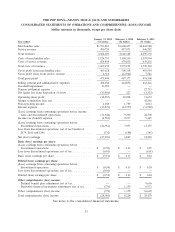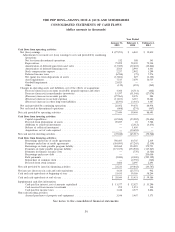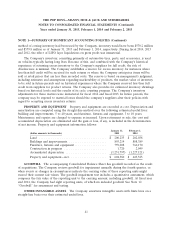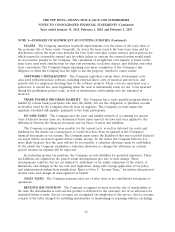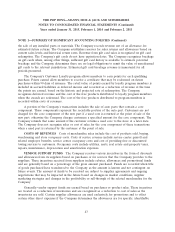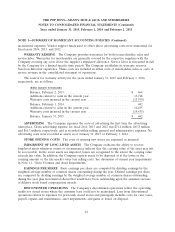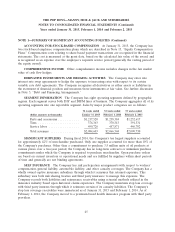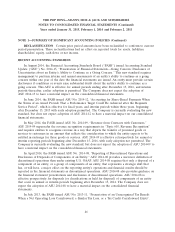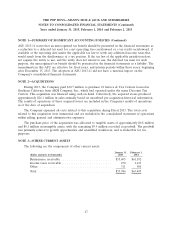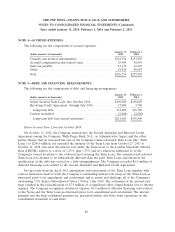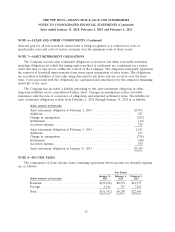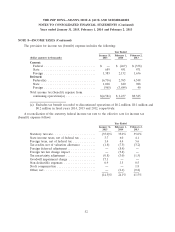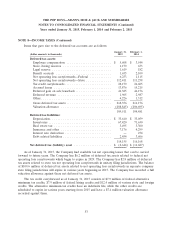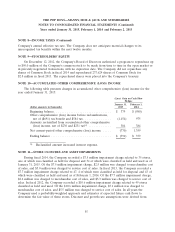Pep Boys 2014 Annual Report Download - page 51
Download and view the complete annual report
Please find page 51 of the 2014 Pep Boys annual report below. You can navigate through the pages in the report by either clicking on the pages listed below, or by using the keyword search tool below to find specific information within the annual report.
THE PEP BOYS—MANNY, MOE & JACK AND SUBSIDIARIES
NOTES TO CONSOLIDATED FINANCIAL STATEMENTS (Continued)
Years ended January 31, 2015, February 1, 2014 and February 2, 2013
NOTE 1—SUMMARY OF SIGNIFICANT ACCOUNTING POLICIES (Continued)
ACCOUNTING FOR STOCK-BASED COMPENSATION At January 31, 2015, the Company has
two stock-based employee compensation plans, which are described in Note 15, ‘‘Equity Compensation
Plans.’’ Compensation costs relating to share-based payment transactions are recognized in the financial
statements. The cost is measured at the grant date, based on the calculated fair value of the award, and
is recognized as an expense over the employee’s requisite service period (generally the vesting period of
the equity award).
COMPREHENSIVE INCOME Other comprehensive income includes changes in the fair market
value of cash flow hedges.
DERIVATIVE INSTRUMENTS AND HEDGING ACTIVITIES The Company may enter into
interest rate swap agreements to hedge the exposure to increasing rates with respect to its certain
variable rate debt agreements. The Company recognizes all derivatives as either assets or liabilities in
the statement of financial position and measures those instruments at fair value. See further discussion
in Note 5, ‘‘Debt and Financing Arrangements.’’
SEGMENT INFORMATION The Company has eight operating segments defined by geographic
regions. Each segment serves both DIY and DIFM lines of business. The Company aggregates all of its
operating segments into one reportable segment. Sales by major product categories are as follows:
52 weeks ended 52 weeks ended 53 weeks ended
(dollar amounts in thousands) January 31, 2015 February 1, 2014 February 2, 2013
Parts and accessories ............ $1,217,520 $1,238,384 $1,252,617
Tires ....................... 376,363 370,313 391,331
Service labor ................. 490,720 457,871 446,782
Total revenues ................ $2,084,603 $2,066,568 $2,090,730
SIGNIFICANT SUPPLIERS During fiscal 2014, the Company’s ten largest suppliers accounted
for approximately 42% of merchandise purchased. Only one supplier accounted for more than 10% of
the Company’s purchases. Other than a commitment to purchase 3.5 million units of oil products at
various prices over a two-year period, the Company has no long-term contracts or minimum purchase
commitments under which the Company is required to purchase merchandise. Open purchase orders
are based on current inventory or operational needs and are fulfilled by suppliers within short periods
of time and generally are not binding agreements.
SELF INSURANCE The Company has risk participation arrangements with respect to workers’
compensation, general liability, automobile liability, and other casualty coverages. The Company has a
wholly owned captive insurance subsidiary through which it reinsures this retained exposure. This
subsidiary uses both risk sharing treaties and third party insurance to manage this exposure. The
Company records both liabilities and reinsurance receivables using actuarial methods utilized in the
insurance industry based upon historical claims experience. The Company maintains stop loss coverage
with third party insurers through which it reinsures certain of its casualty liabilities. The Company’s
stop loss coverage receivables were immaterial as of January 31, 2015 and February 1, 2014. As of
February 1, 2014, the Company moved to a premium-based health insurance program with third party
providers.
45




